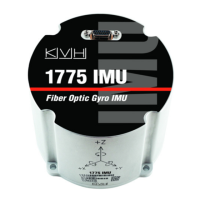This document contains proprietary information of KVH Industries, Inc. and neither this document nor said proprietary information shall be
published, reproduced, copied, disclosed, or used for any purpose without the express written permission of a duly authorized KVH representative.
Page 25 of 77
7.1 Command Definition Conventions
In the following command description sections, the following conventions will be used:
Any parameter surrounded by square brackets ([example]) is a required parameter name,
which will be accompanied by an additional description
Any parameter surrounded by angle brackets (<example>) indicates a set of acceptable
values
Multiple parameters with a “|” separator indicate acceptable discrete values (e.g., <0|1>
indicates that only the values 0 or 1 are acceptable)
Multiple parameters with “-” separator indicate an inclusive range of acceptable values
(e.g., <1-1000> indicates a parameter in the range of 1 through 1000, inclusive, is
acceptable)
Optional parameters are described in command descriptions
Where more complicated alternatives are used, they may be shown in a separate usage
line definition
In the command line usage and responses, the terminating <CR> and <LF> symbols are
implied and not shown
Typically Boolean type parameters that accept a value as <0|1> are defined as FALSE or
OFF if 0 and TRUE or ON if 1
Numeric parameters may be ASCII encoded string representations of one of either integer or
floating-point values (i.e., floats or SPFP) depending on the specific command. Integer type
values, when received as float types, will typically be rejected with a usage response. Floating-
point type parameters may typically be entered as integers (without decimal places).
Exponential notation is accepted also (e.g., 1.2345E-5 instead of 0.000012345). Typically,
single precision float values in IEEE-754 format are only precise to approximately eight places
after the decimal point.

